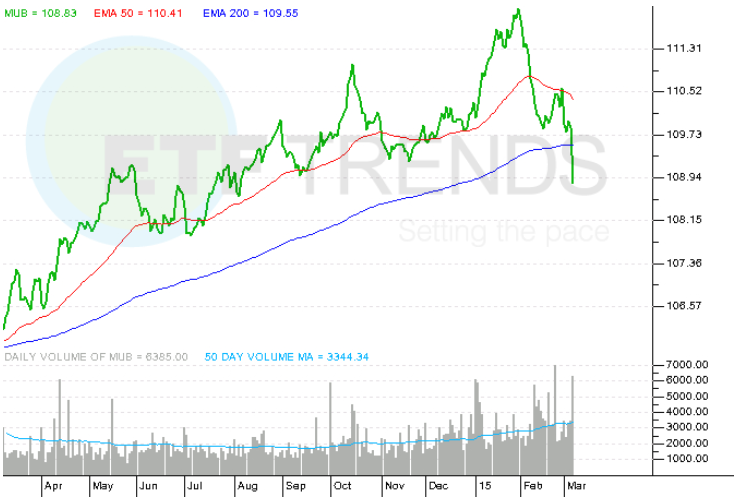What Is A Municipal Bond ETF
Post on: 30 Март, 2015 No Comment

What Is A Municipal Bond ETF?
June 19, 2013
Municipal bonds are worth considering for any investor aiming to conserve capital while receiving a tax-free revenue source. The bondsmunis for shortconsist of debt obligations issued by local governments. Essentially, if you buy a muni bond, you are lending money to the government in return for a promise that the government will pay you back with interest. Local governments then use this money to improve their infrastructure, the education in their area and so forth. As local governments rarely default, muni bonds are seen as some of the safest investments. Additionally, since municipal bonds are tax-free, they offer considerable tax advantages [for more muni bond analysis create a free account today].
While owning a municipal bond might be attractive to some, others may choose to diversify their risk by purchasing a municipal bond ETF. Municipal bond ETFs are comprised of upwards of hundreds of muni bonds. Furthermore, if you are looking for a recurring revenue source, a bond ETF may very well be the solution. ETFs give an investor diversification, reducing the risk.
Advantages and Disadvantages of ETFs
An ETF is an exchange-traded fund. For all intents and purposes, it is a mutual fund that trades like a stock; an investor can buy or sell it on a stock exchange just like they would with a stock.
With this innovative investment vehicle comes a number of advantages. First, expense ratios are much lower in comparison to managed funds. Most fund managers make a lower return than the market, so why not invest that money yourself into a market index of some sort and match the market with minimum fees?
Second, there are no investment minimums. You can buy one share or 1 million, it is up to you and your budget. Third, you can buy them on margin or sell short. If you change your mind you can sell instantly. Mutual funds or other managed funds typically have locked in holding periods.
And last, dividends are reinvested immediately. With managed funds the timing can vary.
Investors typically compare ETFs to other forms of managed funds. In this regard, ETFs do have a lot of advantages. However, there are a few disadvantages to consider especially when comparing an ETF to an individual stock or bond.
First, an ETF may not have as high of a dividend yield as a certain stock. Second, there is no management fee paid to own a stock, so costs of owning an ETF may be higher. And last, low trading volumes on certain ETFs can lead to a bid-ask spread that is too wide, making owning an index or equity much more attractive.
Municipal Bonds in ETFs
Before investing, investors should decide if munis are right for their portfolio. During the credit crisis of 2008 and the recession in 2009 and 2010, the municipal bond market received a lot of negative headlines. Municipalities such as Pennsylvania and Alabama defaulted on their muni bond obligations, and California ran deficits that made others wonder if that state would be next. Muni bonds are also at the mercy of the tax code. If a proposal goes through to take away the interest deduction benefit, then the cost to local tax-payers and the government will increase.
However, muni bond ETFs will draw appeal among baby boomers and those around that age because the volatility is lower than other asset classes. Furthermore, muni bond ETFs provide a steady, tax-free income stream. Many municipal bond ETFs pay out their dividends monthly instead of semi-annually, as do individual muni issues.
Safety and Tax Advantages of Munis
The likelihood of a rated municipal bond defaulting is also negligible. From 1970 to 2011, Moody s showed that only 71 defaults occurred for rated debt. This is out of a $3.7 trillion market consisting of nearly 55,000 issuers. Unrated municipal bond debt tends to be riskier, but that is just the nature of the system.
Moreover, in regards to the tax code, during the past 100 years the government has decided not to tax interest on tax-exempt muni bonds. In all likelihood, it is not likely to do so in the future.
Investing in Muni Bond ETFs
The following are a few municipal bond ETFs investors may wish to consider.
MUB: iShares S&P National Municipal Bond Fund
Founded: 2007
Assets: $3.47 billion
Expense Ratio: 0.25%
This municipal ETF tracks the performance of the investment segment of the U.S. municipal bond market with over 2,000 different holdings.
TFI: SPDR Barclays Municipal Bond Holdings
Founded: 2007
Assets: $1.25 billion
Expense Ratio: 0.20%
This municipal bond ETF tracks the Barclays Capital Municipal Managed Money Index, which is a rule-based market value weighted index designed for the tax-exempt bond market. Inclusions must be rated AA- or higher by the three major credit agencies.
NYF: iShares S&P New York Municipal Bond Fund
Founded: 2007
Assets: $125 million
Expense Ratio: 0.25%
This municipal ETF measures the performance of the investment-grade segment of the New York municipal bond market with over 250 different holdings.
CMF: iShares S&P California Municipal Bond Fund
The Bottom Line
At the end of the day, it is up to the investor to determine if muni bonds are right for their portfolio. If they are, investors should take a look at municipal bond ETFs and diversify some of that risk while they are at it. The long-term impact on an investors income stream will be well worth it. This is especially true for retirees, people in high income tax brackets or people looking for a steady income stream.














